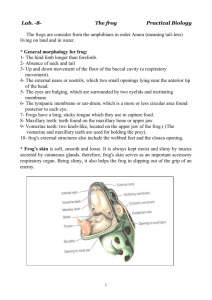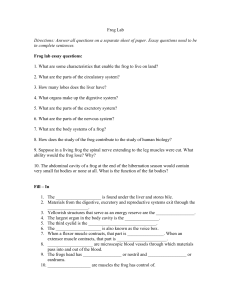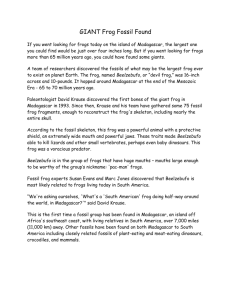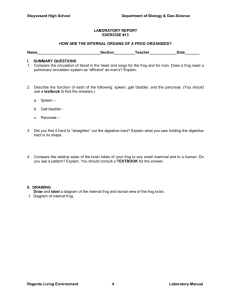Animalia: Frog Physiology - Home Page for Ross Koning
advertisement
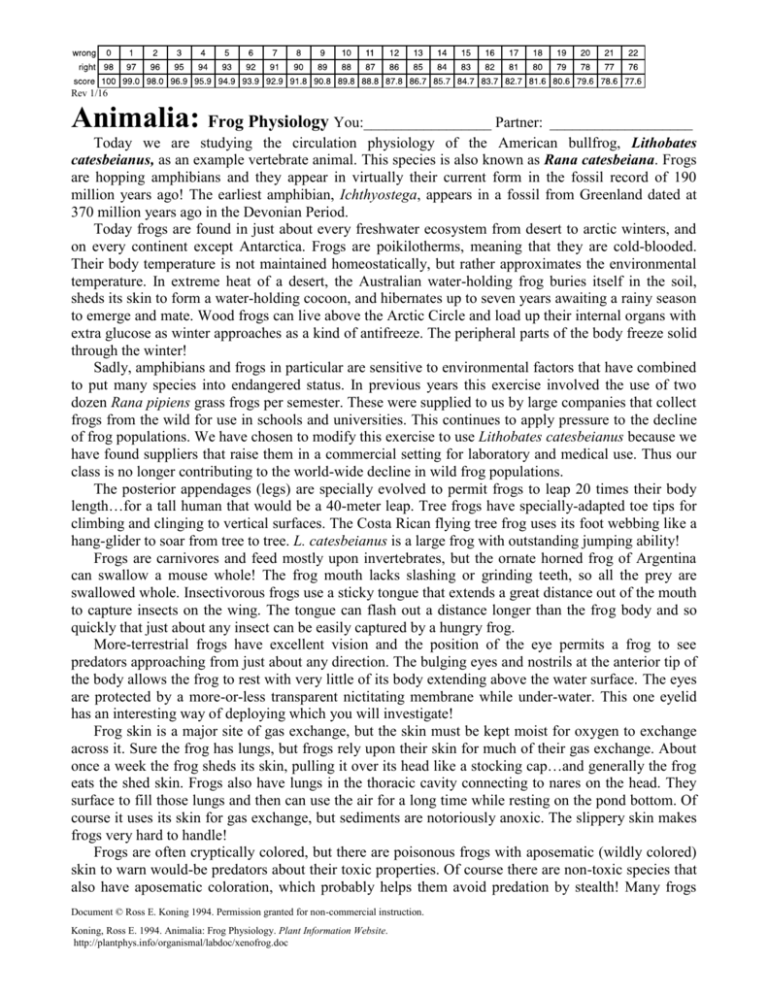
Rev 1/16
Animalia: Frog Physiology You:_________________ Partner: ___________________
Today we are studying the circulation physiology of the American bullfrog, Lithobates
catesbeianus, as an example vertebrate animal. This species is also known as Rana catesbeiana. Frogs
are hopping amphibians and they appear in virtually their current form in the fossil record of 190
million years ago! The earliest amphibian, Ichthyostega, appears in a fossil from Greenland dated at
370 million years ago in the Devonian Period.
Today frogs are found in just about every freshwater ecosystem from desert to arctic winters, and
on every continent except Antarctica. Frogs are poikilotherms, meaning that they are cold-blooded.
Their body temperature is not maintained homeostatically, but rather approximates the environmental
temperature. In extreme heat of a desert, the Australian water-holding frog buries itself in the soil,
sheds its skin to form a water-holding cocoon, and hibernates up to seven years awaiting a rainy season
to emerge and mate. Wood frogs can live above the Arctic Circle and load up their internal organs with
extra glucose as winter approaches as a kind of antifreeze. The peripheral parts of the body freeze solid
through the winter!
Sadly, amphibians and frogs in particular are sensitive to environmental factors that have combined
to put many species into endangered status. In previous years this exercise involved the use of two
dozen Rana pipiens grass frogs per semester. These were supplied to us by large companies that collect
frogs from the wild for use in schools and universities. This continues to apply pressure to the decline
of frog populations. We have chosen to modify this exercise to use Lithobates catesbeianus because we
have found suppliers that raise them in a commercial setting for laboratory and medical use. Thus our
class is no longer contributing to the world-wide decline in wild frog populations.
The posterior appendages (legs) are specially evolved to permit frogs to leap 20 times their body
length…for a tall human that would be a 40-meter leap. Tree frogs have specially-adapted toe tips for
climbing and clinging to vertical surfaces. The Costa Rican flying tree frog uses its foot webbing like a
hang-glider to soar from tree to tree. L. catesbeianus is a large frog with outstanding jumping ability!
Frogs are carnivores and feed mostly upon invertebrates, but the ornate horned frog of Argentina
can swallow a mouse whole! The frog mouth lacks slashing or grinding teeth, so all the prey are
swallowed whole. Insectivorous frogs use a sticky tongue that extends a great distance out of the mouth
to capture insects on the wing. The tongue can flash out a distance longer than the frog body and so
quickly that just about any insect can be easily captured by a hungry frog.
More-terrestrial frogs have excellent vision and the position of the eye permits a frog to see
predators approaching from just about any direction. The bulging eyes and nostrils at the anterior tip of
the body allows the frog to rest with very little of its body extending above the water surface. The eyes
are protected by a more-or-less transparent nictitating membrane while under-water. This one eyelid
has an interesting way of deploying which you will investigate!
Frog skin is a major site of gas exchange, but the skin must be kept moist for oxygen to exchange
across it. Sure the frog has lungs, but frogs rely upon their skin for much of their gas exchange. About
once a week the frog sheds its skin, pulling it over its head like a stocking cap…and generally the frog
eats the shed skin. Frogs also have lungs in the thoracic cavity connecting to nares on the head. They
surface to fill those lungs and then can use the air for a long time while resting on the pond bottom. Of
course it uses its skin for gas exchange, but sediments are notoriously anoxic. The slippery skin makes
frogs very hard to handle!
Frogs are often cryptically colored, but there are poisonous frogs with aposematic (wildly colored)
skin to warn would-be predators about their toxic properties. Of course there are non-toxic species that
also have aposematic coloration, which probably helps them avoid predation by stealth! Many frogs
Document © Ross E. Koning 1994. Permission granted for non-commercial instruction.
Koning, Ross E. 1994. Animalia: Frog Physiology. Plant Information Website.
http://plantphys.info/organismal/labdoc/xenofrog.doc
Page 2
can change their coloration to match their environment (cryptic coloration), or because of their
temperament (lighter when normal and darker when aggressive), or because of the time of day (lighter
in daytime and darker at night). The skin possesses chromatophores to assist in these color changes,
some of which are under hormonal control.
Frogs have vocal cords and vocal sacs that help produce characteristic calls, mostly by males. Frogs
use these sounds to establish territory and to attract mates. Frogs have a large tympanic membrane just
behind the eyes to hear each other’s calls. The mating call of bullfrogs is loud and low, and reminded
people of the roar of an angry bull (bovine)! If a male successfully attracts a female, he mounts on her
back and wraps his forelimbs around the female’s ribcage, interlocking his thumbs. One way to
distinguish male from female frogs in some species is the condition of the forelimb thumbs. The
clasping behavior is called amplexus and it may last hours, days, or even a week or more. Most frogs
are sexually dimorphic; females are generally larger than males.
When the female is fully ready hormonally to shed eggs, she releases hundreds to thousands of eggs
into the water. When this happens, the male on her back sheds clouds of sperm over them. The
syngamy event occurs in the water (external syngamy). In most frogs the zygotes pass through the
tadpole (larval) stage initially as herbivores with very little parental care. However there are other
species that keep the larval frogs in their mouths, stomachs, vocal sacs, or embedded in the skin on
their backs and assist in their feeding, early development, and survival in the face of predation.
Because bullfrogs are so strong and slippery, we will not observe them while still fully alive as they
would easily be maimed or injured unintentionally by falls from the bench, etc.
Euthanasia
In biology we treasure and value the life of an organism as we study it. This will require us to
provide our animal with some level of comfort as we open its body to observe circulation physiology.
Most of you have heard of “pithing” or “double-pithing” a frog, which means inserting a dissecting
needle into the space between the skull and first vertebra, severing the spinal cord, and then driving the
needle into the brain and disrupting it and also running the needle down the channel for the spinal cord
to disrupt most of the frog’s peripheral reflexes. For smaller frogs (such as Rana pipiens) decapitation
with a pair of bone scissors is a faster, more reliable procedure to render the frog paralyzed and
insensitive to our operations. For species with heavily calcified skeletons, cranial compression (skull
fracture and brain collapse) followed by double-pithing is the required procedure.
For this exercise are using bullfrogs that are not fully mature. The skull and vertebral column of this
species and stage of development are not so extensively calcified and the foramen magnum and spinal
cord canal are large enough for us to euthanize them by simple double-pithing. To ensure our
euthanasia is rapid and effective, and as painless for the animal as possible, the instructor will be
euthanizing all of the frogs for the class. You will work in teams of 2 people; if you are uncomfortable
with dissecting a dead animal, be sure to pair up with a classmate who is not worried about this.
Page 3
Laboratory Procedure
External Anatomy
Your frog will arrive dorsal surface up on a dissecting tray. Carefully but quickly observe the
morphology of the frog and make a sketch in the space provided below.
On the edge of the head you will find the mouth. The frog has two anterior pectoral appendages
(forelimbs) and two posterior pelvic appendages (hindlegs). Obviously the frog is a tetrapod vertebrate
animal. The forelimbs have a hand with four digits and a rudimentary/vestigial thumb. The hindlegs
have a foot with five digits and a rudimentary and vestigial sixth digit. The digits of the hindlegs are
webbed for swimming. You might notice the size difference between the forelimb and the hindleg!
Since a bullfrog is a jumping frog, this dimorphism might be expected; its forelimb is used mostly for
posture, so it is very much smaller than the hind limb. The organization of the proximal and distal parts
of each limb is very similar to their counterparts in humans. You should be able to locate the wrist,
forearm, elbow, shoulder and note that the range of motion and direction of folding match your own.
Internally the bone structure and the musculature that operates the forelimb are very similar to those of
your arms. The hind limb is also similar in composition to yours. The thigh is attached with a ball-joint
at the pelvis, there is a knee hinging just like yours, then a shin ending at the ankle and heel of the
foot. The foot of this frog is disproportionately larger than yours, relative to the rest of the hindleg. The
adult frog lacks a post-anal tail and so is called an anuran; the body axis ends with the cloacal opening.
Make a sketch of your frog’s external structure from the perspective of looking down at its dorsal
surface. Orient the frog’s head to the left (9 o’clock) in your sketch (-½). Draw lines from the labels
given below to your sketch. Be sure your lines actually touch the structure named (-½). Plan before you
sketch, so you do not have any crossing lines (-½). Use a { or [ to show longer parts (-½). Pay close
attention to correctly show how the legs are articulated (“fold”); your sketch must be biologically
accurate! Try to avoid the Gumby™ (no joints) look.
digits
foot
eye
tympanum
heel
nares
cloacal opening
forelimb:
hindleg:
shoulder
digits
hand
shin
wrist
forearm
elbow
thigh
knee
-
/14
Page 4
Cardiac Physiology
The main physiology project for today is to observe the frog cardiac muscle directly. The reason for
using a frog heart is that it is rather thin-walled, allowing for rapid diffusion of chemicals that we can
treat it with, and oxygen diffuses easily into the exposed heart. Our frog is no longer breathing.
Moreover, as is true of most poikilotherms, the heart muscle operates over a broad range of
temperatures. So the frog heart will still be beating and will continue to beat for a few hours after
euthanasia.
Assuming lecture has not covered the function of the chemical treatments, let us simply say here
that the poikilotherm heart has a built-in pacemaker (a group of neural cells sending out regular
impulses) allowing the heart to beat for hours even after the brain is no longer connected to the heart!
The nerves that control the heart rate obviously must balance stimulation and inhibition of that
pacemaker to maintain a pulse appropriate for the current conditions. These neurons that connect to the
heart, influence the pacemaker by one of two nerve systems. The parasympathetic nerves slow down
and weaken the contractions by stimulating the pacemaker with acetylcholine secretions…the
sympathetic nerves speed and (especially) strengthen contractions by stimulating the pacemaker with
nor-epinephrine (epinephrine, also known as adrenaline, is a functional equivalent). Acetylcholine and
norepinephrine are called neural transmitter substances. The responding cells must have receptors to
receive these chemicals and respond accordingly. Atropine blocks acetylcholine receptors. Caffeine is a
stimulant that may increase the pulse stimulation rate and also disorganizes the pacemaker’s signals.
We can now proceed to observing the still-beating heart. Be sure that the frog is in the dissecting
tray with the ventral (belly) side facing up.
Using forceps, lift the abdominal skin near the pelvis and snip it open with the scissors. Remember
we want only to cut the skin, so this cut needs to be shallow! Cut the skin up to the edge of the frog’s
jaw. Then cut the skin laterally on each side of the cut so that you can flap the skin open to see the
abdominal muscles. (Your cuts will be in the form of the letter I).
Repeat your cuts just going through the abdominal muscles from pelvis to the ribs. As you flap the
muscle layers open and pin them, you should be able to see the abdominal organs inside the abdominal
cavity.
Dividing the abdominal cavity from the thoracic cavity is a very thin sheet of muscle (looks more
like a “membrane”), the diaphragm. This attaches along the body wall at the level of the lowest rib.
Use the point of the scissors to penetrate the diaphragm just under the rib cage and carefully cut along
the sternum (breastbone) up toward the throat…but BE CAREFUL to keep the scissor points just under
the ribs so that you do not cut into thoracic organs.
After you have opened the thoracic cavity and pinned it open a bit, you should be able to locate the
beating heart. The heart is surrounded by a pericardial membrane; this has a translucent appearance.
Again carefully lift this membrane with forceps and slit it open with the scissors to expose the dark
pink heart. This is a three-chambered heart with one large ventricle and two smaller atria. Quickly
observe the contraction sequence between the two dark-looking atria (right and left) and the lighter
pink ventricle. Also notice the color change that happens as the ventricle contracts, and the degree of
movement of the ventricle with each contraction. These observations are your critical “normal”
function parameters.
From this point onwards the heart needs to be kept moist. Apply isotonic room-temperature Frog
Ringer’s solution (6.5 g NaCl + 0.14 g KCl + 0.12 g CaCl2 + 0.2 g NaHCO3 + 0.01 g NaH2PO4•H2O
per liter) to the heart muscle and other internal organs to keep them from drying out. All of the drugs
you will be using in this project are dissolved in Frog Ringer’s solution. You should never use distilled
water to moisten internal tissues; the cells lack cell walls and contractile vacuoles!
Page 5
Make ventricle pulse observations over one full minute for each trial for our “control” setting. Add
one drop of Ringer’s solution to the heart muscle between the five trials. 10 pt.
Treatment:
Trials: 1
2
3
4
5 x bpm
Contraction Quality
Ringer’s control
.
weak normal strong
What is the basal heart beat of a frog? _____ bpm. What is your basal heart beat? ______ bpm
After the fifth trial, blot out the excess Ringer’s solution with a wad of dry paper towel.
Immediately apply a few drops of acetylcholine dissolved in Ringer’s solution. Allow one full minute
for the chemical to diffuse into the heart muscle.
Then repeat your pulse observations. 8 pt.
Treatment:
Trials: 1
2
3
4
5 x bpm
Contraction Quality
0.3% acetylcholine
.
weak normal strong
If acetylcholine stops the heart, blot out the acetylcholine immediately, apply the atropine
(dissolved in Ringer’s) solution to counteract it and to soon restore the heartbeat (then enter 0 for the
rest of the trials for acetylcholine). Is a heart massage needed? Get the heart restarted (if needed) and
allow one full minute for the atropine to diffuse into the heart muscle.
Then repeat your pulse observations. 8 pt.
Treatment:
Trials: 1
2
3
4
5 x bpm
Contraction Quality
0.5% atropine
.
restored not restored
Blot out the atropine solution and apply a few drops of the nor-epinephrine (dissolved in Ringer’s)
solution to the heart. Allow one full minute for the nor-epinephrine to diffuse into the heart muscle.
Then repeat your pulse observations. In determining the relative strength of the contraction, compare
what you have seen in terms of the amount of heart movement and the relative color change between
the relaxed and contracted ventricle. 8 pt.
Treatment:
Trials: 1
2
3
4
5 x bpm
Contraction Quality
0.3% norepinephrine
.
weak normal strong
Blot out the nor-epinephrine solution and apply a few drops of the caffeine (dissolved in Ringer’s)
solution to the heart. Allow one full minute for the caffeine to diffuse into the heart muscle.
Then repeat your pulse observations. In determining rhythm of contraction, compare the normal
sequence of the atrial contractions and ventricular contractions to anything that the caffeine may
induce. 8 pt.
Treatment:
Trials: 1
2
3
4
5 x bpm
Contraction Rhythm
1% caffeine
.
regular irregular
Now that your chemical treatments and timed intervals are over, you can proceed in a more relaxed
way. Blot out the caffeine solution, and add a few drops of plain Ringer’s solution. Complete your
examination of the chest cavity by noting that blood from three dorsal veins including the posterior
vena cava join together beneath the heart to form the sinus venosus. This feeds blood from the body
into the right atrium (on your left!). The left atrium (on your right) receives oxygenated blood from
the lungs. The ventricle pumps blood into the conus anteriosus passing ventrally over the right atrium.
It then divides into branches including the dorsal aorta.
-
/42
Page 6
Since you have been looking at it for such a long time, sketch this anatomy to commit your
experimental environment to your notes. Make a diagram of the chest cavity of your frog (use your
cranial zoom!) and label it by linking the structures sketched to the words in the word bank. Be sure
your lines actually touch the structure named. Plan before you sketch, so you do not have any crossing
lines. Blanks are provided for you to indicate color of the structure (clear is not a color, watch out for
“white”). Biology is not a place for Picasso (cubist) sketches!
rib cage
pericardium __________
atrium ___________
ventricle ___________
Mouth Anatomy.
Turn your frog over and examine the inside of the mouth. The bullfrog has a long tongue for
capturing insects as prey; it is more of an ambush predator. It grasps the prey in its mouth and swallows
it whole. A rise in the floor of the mouth is the larynx with an opening held shut by two vocal cords.
Find this opening to the trachea and spread apart the vocal cords.
The vocal cords open left-to-right anterior-to-posterior
Return your attention to the possibly-severed head and notice that vomerine teeth normally found
in the hard palate of frogs. Slide your dissecting needle along the margins of the upper jaw (the
maxilla) being sure to be inside the frog’s lips. You should be able to feel the texture of the maxillary
teeth.
The teeth are equal unequal in size and point back to the throat straight up from jaw
Eye Anatomy.
Flip over the frog’s body head and use your dissection microscope to get a close look at the eye.
Terrestrial frogs generally have large eyes which are useful for predation and protection from prey in
crepuscular and nocturnal situations. In the space below, make a sketch of the eye and label it clearly as
for previous sketches. You will need to use a dissecting needle to lift the nictitating membrane to find
it! This more or less transparent membrane (eyelid) serves to protect the eye under water. Blanks are
for colors.
____________ pupil
___________ iris
nictitating membrane
The nictitating membrane deploys to cover the cornea from: top-down
bottom-up
It might be interesting to remove and cut open the eyeball to release the lens from the inside of the eye;
it should be transparent and surprisingly solid in texture. This may also reveal the deep purple
(rhodopsin) retina layer inside the eyeball.
-
/16
Page 7
Abdominal Cavity.
Posterior to the chest cavity you have watched so closely, there is a larger abdominal cavity. If your
frog is female, this area could be dominated by olive-khaki eggs and light pink oviducts. There will
also be a fair bit of yellow to orange adipose (fat) tissue. Carefully pull out and snip the eggs and
oviduct tissues being careful not to disturb the digestive and other systems that are internal to all of this
reproductive system.
Just anterior to the eggs and oviducts, you will find the large and brown liver. As you trace its
edges you will see that it is lobed. As you lift sections of the liver (on your left) slightly you will find
the pink-to-greenish gall bladder attached into its lower surface. The bile enters the digestive system at
the beginning of the intestine. Beneath the liver (on your right) you should find a whitish j-shaped
muscular stomach connecting anteriorly to the wide esophagus and posteriorly to the intestine (small
in diameter, but long in length!). On its posterior surface you may find the lumpy off-white pancreas.
The pancreatic duct leads digestive enzymes into the beginning of the intestine where enzymatic
digestion and nutrient absorption occur. The later part of the intestine is where water absorption occurs.
The intestine empties into the cloaca where the adjacent collapsed bladder also empties. Beneath the
pubic bone the cloaca exits the body at the anus. The cloaca vents to the outside from the reproductive,
urinary, and digestive systems.
Cut the digestive system at the esophagus well above the stomach and again at the cloaca near the
anus, and remove the entire digestive system to a paper towel in one piece. Do not disarticulate the
sections of the digestive system! This is a shortcoming of all those PC-Frog on-line dissection
software programs. We want you to see the system as it is connected together and functioning as a
whole sequenced system. Stretch out the digestive system to straighten it. You may need to cut
mesenteries (the connectives that keep the conformation of the intestine in proper folded orientation
and have many hepatic-portal blood vessels to extract and duct nutrients from the intestine to the liver).
Make a sketch of this system in its stretched-out-straight condition (esophagus to left, cloaca to
right!); be sure to use your "cranial zoom" to fit it into the space below. Try to get relative sizes,
diameters, and lengths right. Label your sketch as before. Shade in the organs to show relative colors,
and label the colors in the blank above each label etc. It is highly doubtful that any structure here is
truly white to a biologist!
esophagus
stomach
pancreas
liver
gall bladder
spleen
cloaca
/
/
/
/
/
/
/
/
esophagus
Snip out the gall bladder. Blot it with paper towel. Place it on a fresh piece
of white paper towel and pierce it with the dissecting needle. What color is bile? ________________
-
/17
Page 8
Looking deeper in the abdominal cavity you will find two bilateral brownish kidneys with a pinkwhite adrenal gland at the anterior end of each. These lie close to each other just above the backbone
and are surrounded by a dense capillary system. The ureters conduct urine to the urinary bladder that
empties into the cloaca. Make a sketch at this level and label it, as always, avoiding crossing lines and
touching the object demonstrated with the line you draw to it. The blanks are for colors.
adrenal gland __________
kidneys ____________
bladder ____________
cloaca
After removing the two kidneys, the body cavity is now mostly empty. You should notice the very
long pelvic wings with attached musculature on either side of the basal section of the vertebrae.
Emerging from the two sides of the segmented and whitish vertebral column are several linear white
peripheral nerves extending along the dorsal interior of the abdominal cavity and distally toward the
legs on each side. By now you realize that your frog is dead; nevertheless, use your forceps to rub and
pinch these peripheral nerves on one side of the vertebral column. Make several attempts and observe
the responses; have your lab partner stimulate the nerves on the other side of the vertebral column.
What was the response? ___________________________________________________________
The leg that responded, relative to the nerve stimulated, was on the same
-
/9
opposite side.



